Henry "Hap" Arnold, 1923
(Source: NASM)
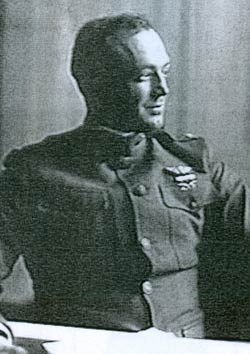 |
Henry "Hap" Arnold has a strong presence in the military history literature and online. Reputedly, the nickname "Hap" came from his normal facial expression, which usually looked like he was ready to smile. He was born in Gladwyne, PA on June 25, 1886, seventeen years before the Wright brothers flew. He came of age when aviation was very much in its infancy. Image, left, from his NASM biographical file (cited left sidebar), was taken in 1923.
He graduated from West Point in 1907 and was assigned to the Signal Corps. Arnold learned to fly at Dayton, OH during May 1911. He soloed in 10 days, after three hours and 48 minutes of instruction in 28 flights. He held pilot's certificate number 29. His instruction was under the supervision of the Wright brothers at their school at Dayton.
Below, are two interesting, brief and candid letters written long-hand by Arnold during May 1911. These letters, from his NASM biographical file (cited left sidebar), document his training progress and solo. He cites 24 of his 28 flights, and announces his solo status by stating, "...from now on all my flights will be made alone for experience."
This first letter documents also the type of flight controls on the Wright Flyer he flew. He was, as a lieutenant, "...handling the warping and elevator levers...." He was promoted to captain ca. 1916, and, with the beginning of WWI, to major in 1917, and then to temporary colonel as executive officer of the Signal Corps Aviation Division.
H.H. Arnold, Flight Training Progress Letter, May 6, 1911
(Source: NASM)
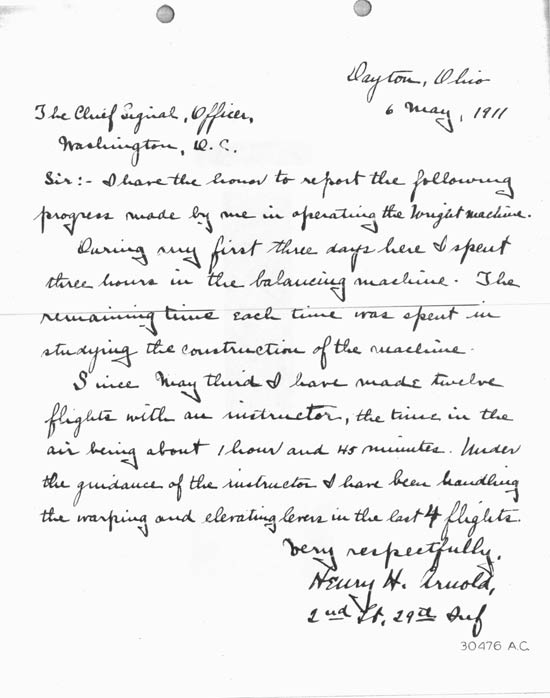 |
In 1912 he set an altitude record of 6,540 feet. On another flight he reported the movements of ground troops from the air by radio for the first time. For this he was awarded the Mackay Trophy.
H.H. Arnold, Flight Training Progress Letter, May 13, 1911
(Source: NASM)
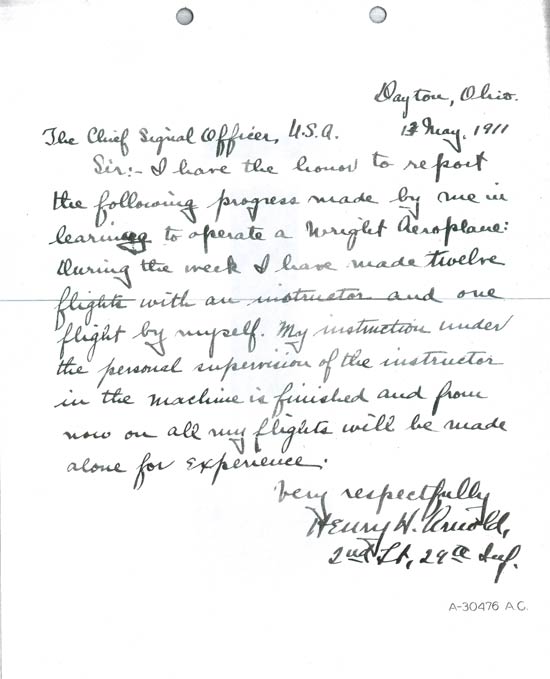 |
At the beginning of WWI in the Aviation Division there were 52 officers (Arnold was the senior officer with wings), 1,100 enlisted men and 200 civilians, and 55 obsolete aircraft in the inventory.
Below, an image from friend of dmairfield.org John Undewood. This photograph was taken in 1916, just before WWI.
H.H. Arnold, 1916 (Source: Underwood)
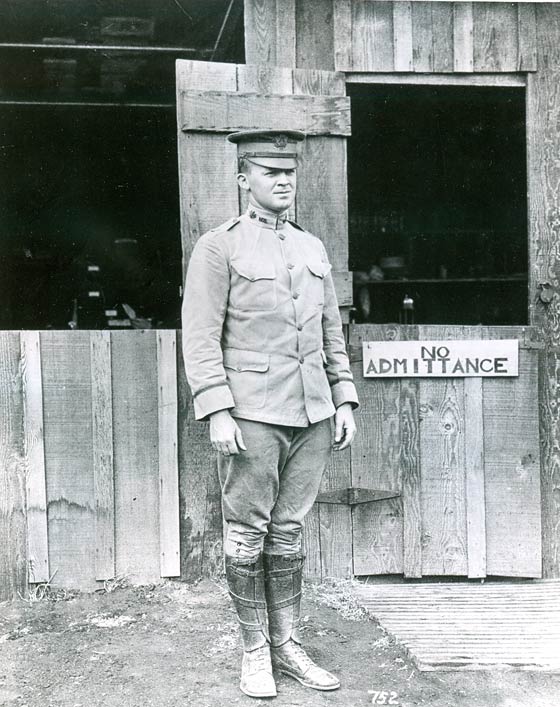 |
I tried adjusting the contrast of this image to peer into the building, but could distinguish nothing aviation-related. It looks like a workshop or storage area with cans on shelves. Below, the caption on the back of this photograph. I cropped and enhance the contrast in PhotoShop for easier reading. Note that, although the photo was taken in 1916, it was celebrated later during the 95th anniversary of the U.S. Signal Corps.
Caption: H.H. Arnold, 1916 (Source: Underwood)
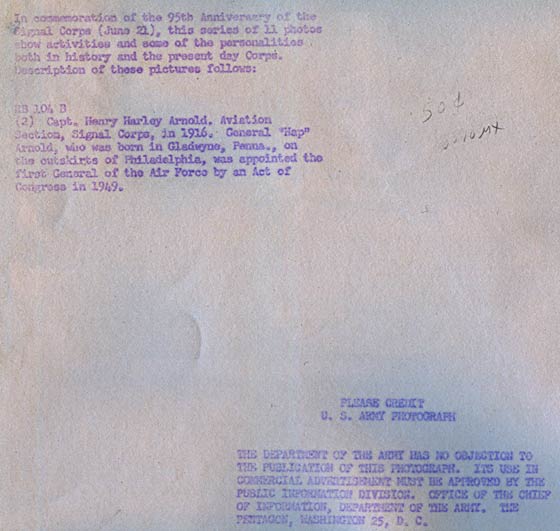 |
Arnold became Assistant Director of Military Aeronautics. He assisted in establishing an air mail service between Washington, DC, Philadelphia, PA and New York City. The mail service provided means for military pilots to perfect cross-country flying techniques.
Major Hap Arnold, Ca. 1917 (Source: SDAM)
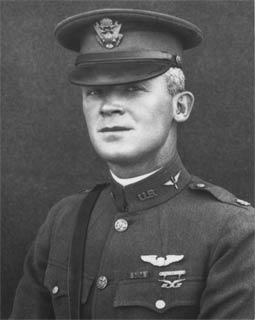 |
Rather than repeat a lot of existing information about his leadership assignments during WWII, here are a couple of links to further biographical information. Arnold was an original Early
Bird. This link gets
you his records archive at the Library of Congress. There
you will find the definitive source of his military, official
and family writings.
Hap Arnold landed twice at the Davis-Monthan Airfield, on Monday March 17, 1930
and on Wednesday August 23, 1933. On March 17 he was solo in Douglas O-2, 29-218. Baugher identifies his airplane as a Douglas O-32 s/n 543. It was a dual control trainer. Its designation changed to BT-2. It was assigned to Wright Field as P-568.
On August 23, 1933 he landed solo as a Lt. Col. flying Boeing P-12-E, 32-100. Based at Riverside, CA March Field, he was southbound to Bisbee, AZ.
Interestingly, according to lore, when he was learning to fly in 1911 he was snapped in the
eye by a bug. To preclude future pokes in the eye, he purchased
a pair of motorcycle goggles and pioneered the use of goggles
in airplanes.
Below, two images of Arnold. The left image shows Arnold with Register pilot Major Thomas Dewitt Milling on the right in the cockpit of an unidentified airplane. Interestingly, Milling learned to fly with Wrights at the same time Arnold was at Dayton. Arnold and Milling were then assigned to College Park MD, the country's first military airfield, where they became instructors. At that time, there were only three qualified Army pilots. All three of them later signed the Davis-Monthan Airfield Register. They were Arnold, Milling and Benjamin Foulois. But, see also Register pilot Roy C. Kirtland.
The right image shows Arnold solo in the cockpit of an unidentified airplane.
In Cockpit, March Field, Riverside, CA 1934 (Source: NASM)
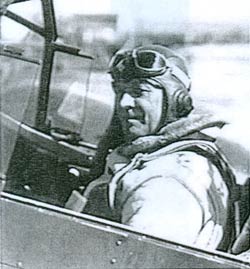 |
With Maj. T.D. Milling, Sacramento, CA, 1931
(Source: NASM)
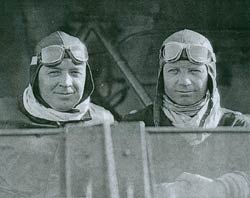 |
Below, an image also from friend of dmairfield.org John Undewood. It shows Arnold with Hollywood actress Bebe Daniels. Daniels was the wife of Register pilot Ben Lyon.
H.H. Arnold and Bebe Daniels, October 30, 1932 (Source: Underwood)
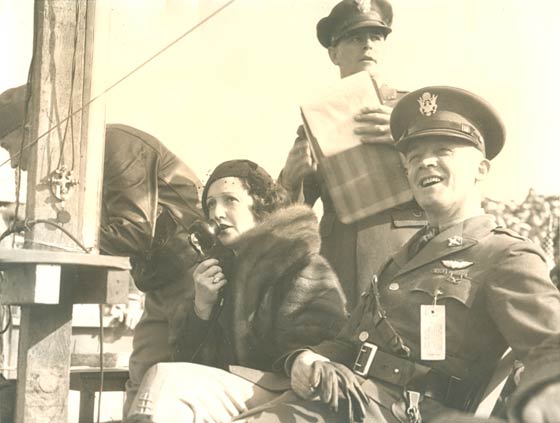 |
This is an interesting photograph. As Commanding Officer of March Field, Arnold invited Daniels as his personal guest to joint Army-Navy maneuvers that day at Long Beach, CA on October 30, 1932. Daniels appears to be speaking into a public address system. Note the morse key mounted on the post at left representing Golden Age communications redundancy. Daniels retired from acting in 1935 and moved to England.
Another photo taken the same day shows Daniels and Arnold standing in front of a P-12 fighter taken at Long Beach, below.
H.H. Arnold and Bebe Daniels, October 30, 1932 (Source: Link)
 |
In 1934, Arnold led a flight of Martin B-10 bombers from Bolling Field, Washington, DC to Fairbanks, AK and back. Image, below, shows Arnold, his crew members and other unidentified persons. The B-10s are in the background.
Alaska Trip Publicity, 1934
(Source: NASM)
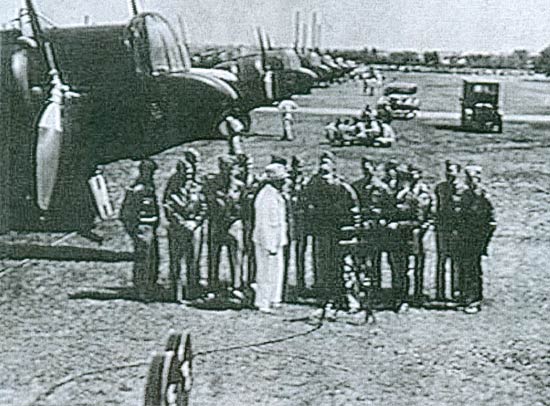 |
This ceremonial assembly of the Alaska personnel appears to be a publicity event, as there is a camera set up in the foregroung (double film reel visible at bottom of image), and there is a microphone and wiring visible.
Arnold, right, and Foulois
(Source: NASM)
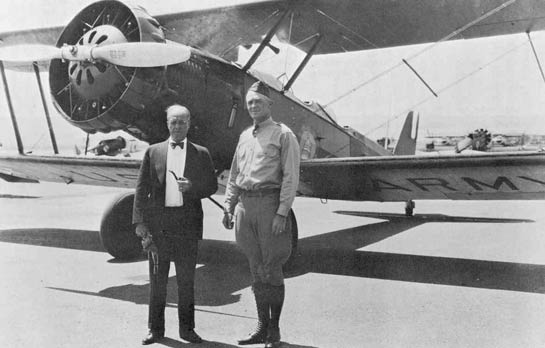 |
Image, above, of Col. Arnold, right, and Gen. Foulois.
Army Douglas O-38 in background. To see another image of Arnold,
please follow this link to the Klein
Archive of Aviation Photographs.
Below, a cornerstone letter from Arnold's NASM dossier. One of Arnold's first acts after WWII ended (note date), and last acts as General of the Air Force, was to establish a tangible record of the history and technical background of aviation technologies in the U.S. and the world. He directed that significant examples of aircraft and components be collected for educational display and preservation.
Founding of the National Air & Space Museum
(Source: NASM)
 |
This order was one of the fundamental steps which led to the founding of the National Air & Space Museum. The Museum, administered by the Smithsonian Institution at Washington, is now the most famous and most visited museum in the world. It is custodian for many of the most famous aircraft, including the Wright Brothers' "Kitty Hawk Flyer", the "Spirit of St. Louis", and pioneer aircraft of the Golden Age, WWI, WWII and representative commercial types (e.g. Northrop Alpha 2, NC11Y) and a Boeing 247 flown by John Miller.
Further, it is significant to note this example of how the pilots of the Davis-Monthan Register weave through each others' lives. Arnold's letter soliciting ideas and support for the Museum is addressed to Register pilot Reuben Fleet. This is one of many examples throughout dmairfield.org where our Register pilots "bump into" each other, sometimes many years hence, and miles apart.
Arnold suffered a series of heart attacks and died of the last on January 15, 1950. He was only 63 years old. He had never fired a gun or dropped a bomb in anger, rather he helped develop the largest air force in the world.
---o0o---
Dossier 2.2.2
UPLOADED: 06/05 REVISED: 09/03/06, 09/30/07, 02/21/08, 01/21/10, 06/30/11, 12/20/11, 05/08/19, 01/06/23
|














